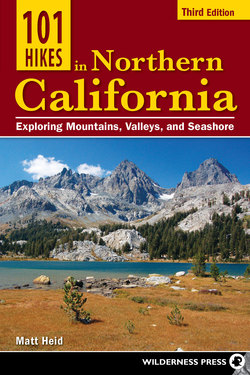Читать книгу 101 Hikes in Northern California - Matt Heid - Страница 25
На сайте Литреса книга снята с продажи.
ОглавлениеHIKE 8 Fremont Peak
Highlight Superlative view of the entire Monterey Bay
Distance 1.0 mile
Total Elevation Gain/Loss 350'/350'
Hiking Time 1 hour
Recommended Map USGS 7.5-min. San Juan Bautista
Best Times After winter storms
Agency Fremont Peak State Park
Difficulty
ATOP FREMONT PEAK on March 6, 1846, John C. Frémont defiantly raised the first American flag in California. Three days later, as he sat surrounded by Spanish forces threatening to attack, his flagpole blew down. Taking this as a bad omen, Frémont departed and left behind this unrivaled panorama of Monterey Bay.
The Hike is a quick and easy ascent of Fremont Peak (3,169'), a prominent summit due east from the center of Monterey Bay. Unparalleled views are the reason to come here, making it critical to correctly time your visit. The air is cleanest and the grass greenest immediately following winter storms, but air quality rapidly declines without rain and will usually begin to deteriorate within 24 hours. Prepare for chilly and windy conditions during the winter months. Fog can completely obliterate the view during the summer. Crowds are minimal, especially in the winter. Water is available in the nearby campground.
To Reach the Trailhead Take Hwy. 156 east of Hwy. 101 for 3 miles to San Juan Bautista and head south on the Alameda (Hwy. G1). Approaching from the east, the turnoff is 9 miles past the junction of Hwys. 156 and 25. Immediately bear left on San Juan Canyon Rd. (Hwy. G1) at the complex four-way intersection and proceed 11 miles to the upper parking lot at road’s end. There is a nominal day-use fee.
Description From the trailhead, proceed up the paved road signed AUTHORIZED VEHICLES ONLY. A singletrack dirt trail quickly splits off across from a few, stout Coulter pines, passing through coyote brush punctuated by some valley oaks and small madrones. It wraps around the western slope where the antenna complex comes into view. A series of short switchbacks leads you to the rocky summit.
Savoring the view, ignore the antennas as you behold the curving expanse of Monterey Bay. Its southern arm is formed by the Monterey peninsula, visible beyond the city of Salinas. Its northern end contains south-facing Santa Cruz on its shores. Two main rivers drain into Monterey Bay: the longer Salinas River on the south, which flows 190 miles northwest through the broad Salinas Valley, and the Pajaro River on the north, which flows by Watsonville before entering the bay near its center. Between the two is Elkhorn Slough, a tidal embayment extending 7 miles inland whose mouth is marked by the enormous 500-foot-high boiler stacks of the Moss Landing Power Plant. The slough is a haven for birdlife—it once held the North American record for the most bird species seen from a single location in one day (116). The broad alluvial plain around Monterey Bay is rich agricultural land and annually produces the country’s largest crop of artichokes.
Immediately offshore of Elkhorn Slough is the beginning of Monterey Canyon, California’s deepest submarine canyon. Twisting slightly southwest, it reaches a depth of 6,000 feet less than 15 miles from the shore, almost twice the elevation of Fremont Peak, which is 16 miles from the shore. To create so deep a submarine canyon requires erosive power far greater than that provided by the current rivers that flow into Monterey Bay. To explain its origin, theory holds that in the recent geologic past (up to 5 million years ago) a large amount of California water drained through present-day Monterey Bay unhindered by any Coast Ranges, carving a deep offshore canyon over the course of millions of years. As the San Andreas Fault system moved Monterey Bay north, the rising Coast Ranges limited its drainage basin to its current watershed. Cold water upwelling from March through September funnels nutrient-rich waters up Monterey Canyon, providing sustenance for the incredible diversity of sea life that makes Monterey Bay world famous.
Nearest Visitor Center There is no staffed visitor center. Call 831-623-4255 for general information. An astronomical observatory near the summit offers public programs; call 831-623-2465 or visit fpoa.net.
Nearest Campground Fremont Peak State Park Campground (25 sites, $25) is below the summit and is lightly used except on the busiest weekends. For reservations visit reserveamerica.com or call 800-444-7275.
Additional Information www.parks.ca.gov
